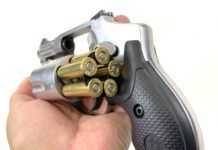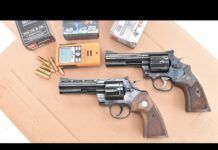Before law enforcement changed over to semi-automatic pistols, most officers carried a 357 Magnum revolver. Though some write off revolvers as the firearms equivalent of rotary phones, many of our staff consider the revolver to be a simple-to-operate self-defense firearm with built-in safeties and no magazine to lose. We also like the 357 Magnum cartridge. In addition to self-defense use, some team members have used the round to hunt medium-size game, so power isn’t an issue.
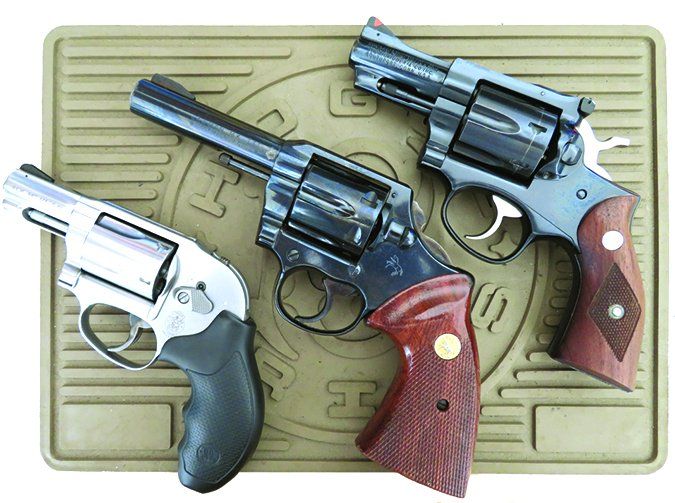
Because a good revolver stands the test of time and usage well, but also depreciates enough to become affordable for more folks, we assembled three used revolvers from what was once the big three of U.S. revolver manufacturers—Colt, Smith & Wesson and Ruger. In general, we would rate the condition of these revolvers from 80 to 90 percent by NRA standards—we could tell they have been used, but we could not see where they had been abused. All samples were chambered in 357 Magnum, and all were designed for self-defense with barrel lengths that ranged from 2.15 inches to 4 inches and double-action/single-action trigger modes. Safeties are built into these three revolvers. The S&W uses a hammer stop, while the Ruger and Colt use hammer transfer bars.
From that starting point, this pack then diverged, with each offering characteristics that ranged from thumbs-down to thumbs-up for our shooters. Some incorporated an excellent grip that helped tame the felt recoil of the 357 Magnum; some were slim and more easily carried concealed, and some were equipped with large, easy-to-align sights.
With any used revolvers, we have a process of testing the chamber-barrel alignment with a range rod, and we found all were aligned. We also check the timing to see how the cylinder rotates in DA mode and SA mode to ensure the chamber is aligned with the bore of the barrel. They were. We also look at the gap between the front of the cylinder and the forcing cone or rear of the barrel. We use a feeler gauge and expect to have .006 clearance. Any less and there is a chance the cylinder may bind after shooting as fouling builds up. Any more and the user might experience splatter from burning gases escaping from the gap. We also look for forward and rearward play in the cylinder when locked in the frame. These revolvers were tight and stood as good examples of the revolver manufacturers’ art and science.
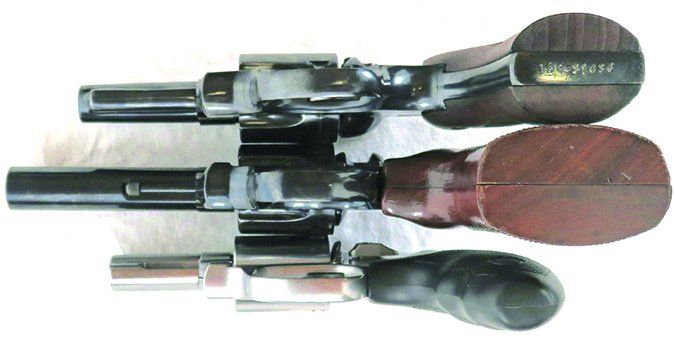
We tested accuracy at 25 yards, which pushed the envelope of these revolvers’ capabilities, depending on the user. We also found these revolvers had good accuracy. In close-range testing, some of these revolvers could get lead downrange fast and in good groups. Test ammunition consisted of Winchester PDX1 Defender 357 Magnum with a 125-grain bonded jacket hollowpoint, Aguila 357 Magnum with a 158-grain semi-jacketed hollowpoint, and SIG Sauer 38 Special +P, loaded with a 125-grain jacketed hollowpoint.
We had no issues with any of the revolvers. They all performed in DA and SA mode and loaded and ejected empties if we did our part and used gravity to our advantage. We did find that the S&W had the advantage as a concealed-carry revolver, but the Ruger and Colt were quite capable. Here’s what we found out about these handguns after the brass cooled.
Range Data
| SIG Sauer 38 Special +P 125-gr. JHP | Ruger Security Six | Colt Lawman Mk III | Smith & Wesson Model 649 |
| Average velocity | 920 fps | 936 fps | 910 fps |
| Muzzle energy | 235 ft.-lbs. | 243 ft.-lbs. | 230 ft.-lbs. |
| Smallest group | 1 in. | 1.4 in. | 0.9 in. |
| Average group | 1.5 in. | 2 in. | 2.4 in. |
| Aguila 357 Magnum 158-gr. SJHP | |||
| Average velocity | 1155 fps | 1208 fps | 1107 fps |
| Muzzle energy | 468 ft.-lbs. | 512 ft.-lbs. | 430 ft.-lbs. |
| Smallest group | 0.8 in. | 1.5 in. | 1.6 in. |
| Average group | 1.4 in. | 2.2 in. | 2.3 in. |
| Winchester 357 Magnum PDX1 Defender 125-gr. JHP | |||
| Average velocity | 1136 fps | 1118 fps | 1082 fps |
| Muzzle energy | 358 ft.-lbs. | 347 ft.-lbs. | 325 ft.-lbs. |
| Smallest group | 1.1 in. | 1.9 in. | 1.8 in. |
| Average group | 1.6 in. | 2.4 in. | 2.3 in. |
| To collect accuracy data, we fired five-shot groups from a bench using a rest. Distance: 25 yards. We recorded velocities using a ProChrono digital chronograph set 15 feet from the muzzle. | |||
Smith & Wesson Model 649 357 Magnum, $500-$525
GUN TESTS GRADE: A
The 649 was lightweight, thin, and concealable. It offered the ability of single-action or double-action operation in a snag-free exterior. Even with 357 Magnum loads, recoil was tolerable.
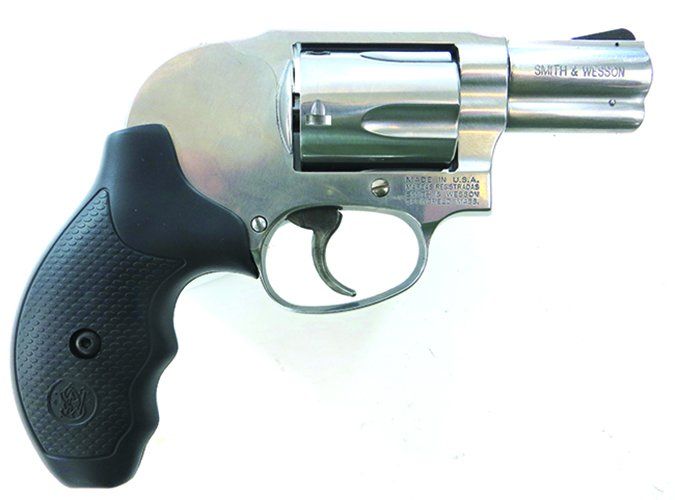
| ACTION TYPE | Double action |
| OVERALL LENGTH | 6.6 in. |
| BARREL LENGTH | 2.125 in. |
| SIGHT RADIUS | 3.8 in. |
| OVERALL HEIGHT | 4.6 in. |
| MAX WIDTH | 1.3 in. |
| WEIGHT UNLOADED | 22.2 oz. |
| WEIGHT LOADED | 26.3 oz. |
| CYLINDER GAP | .008 |
| CAPACITY | 5 |
| FRAME FINISH | Bright stainless |
| BARREL/CYLINDER FINISH | Bright stainless |
| FRAME FRONT STRAP HEIGHT | 2.2 in. |
| FRAME BACK STRAP HEIGHT | 3.5 in. |
| GRIP | Checkered rubber/finger grooves |
| GRIP THICKNESS (max) | 1 in. |
| GRIP CIRCUMFERENCE (max) | 4.7 in. |
| FRONT SIGHT | Ramped pinned blade |
| REAR SIGHT | Fixed groove |
| TRIGGER PULL WEIGHT (DA) | 13 lbs. |
| TRIGGER PULL WEIGHT (SA) | 3.3 lbs. |
| SAFETY | Internal hammer block |
| WARRANTY | Limited warranty |
| TELEPHONE | (800) 331-0852 |
| WEBSITE | Smith-Wesson.com |
| MADE IN | USA |
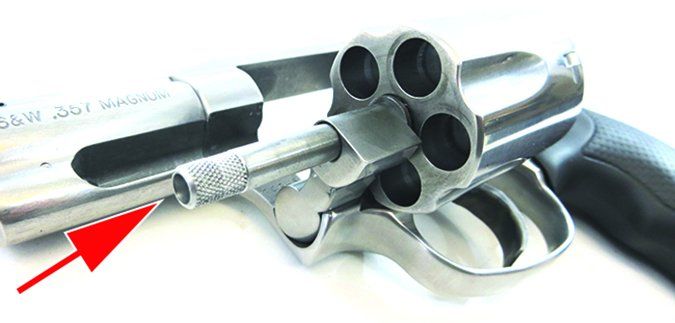
The Model 649 is built on a J frame, which limited this 357 Magnum to a five-round capacity. The model is a variation of the Model 49 Bodyguard and is still currently produced. There is a reason for its longevity.
The finish was bright stainless, and even with the 2.125-inch barrel, the 649 had some heft. If it were lighter, no doubt the revolver would have battered our palms. In our opinion, the Model 649 offered a good compromise on size, round capacity, sights, weight, and bulk. The barrel had a full underlug that shrouded the ejector rod. The hammer was shrouded, so there was no hammer spur to snag on clothing during a draw, but the knurled hammer still allowed the revolver to be cocked and fired in single-action mode.
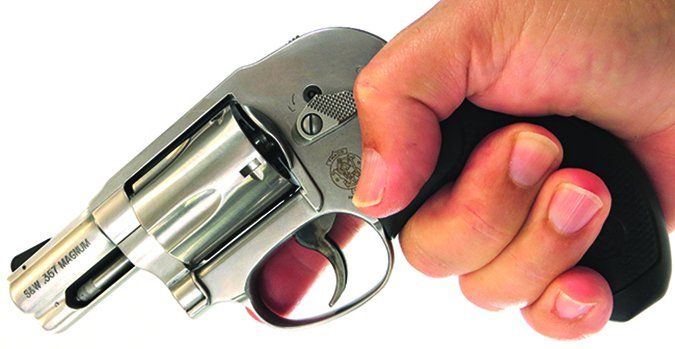
The 649 had, by far, the best double-action and single-action trigger strokes of the three revolvers tested. The sights were small, like on the Colt, but had better contrast. The front-blade sight was blued steel and pinned and could be replaced to match a certain load. We like this feature. The rear sight was a groove in the top strap of the bright stainless steel frame and offered good contrast compared to the Colt.
The grip was made of rubber with finger grooves, and felt thin, which made it easier to conceal but also inflicted more felt recoil, although it was tolerable with 357 Magnum loads in our test.
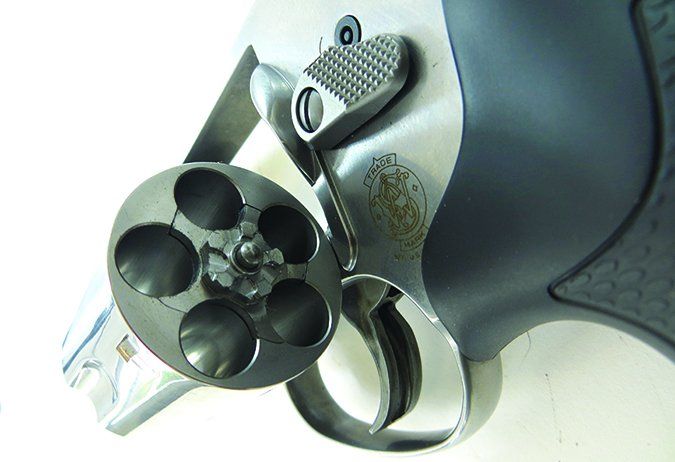
At 25 yards while shooting off a bench, the S&W was slightly easier to shoot than the Mk III, even with the smaller sights and smaller grip. We attribute this to the better trigger. The S&W had the best trigger, with no stacking and a smooth, consistent DA pull. The SA pull was light and crisp. We also liked the snag-free exterior of the 649. This revolver could be drawn from a pocket smoothly, unlike the Ruger and Colt. It was also thinner, so it was the easiest of the trio to carry in an IWB holster. The thinner grip also helped concealability. Felt recoil was the most severe with the S&W compared to the other revolvers, shooters said.
Our Team Said: The 649 was the best compromise of concealability, shoot-ability, and firepower. The trigger was superior, and there were aftermarket grips available if owners want to change out the grip. As we mentioned above, the Model 649 is still being offered as a new product (163210), so if you don’t like buying used, then spend more and buy it new.
Ruger Security Six 357 Magnum, $400-500
GUN TESTS GRADE: B+
The Security Six had good accuracy with user-friendly sights; recoil was mild due to its bulk, which also made it less suitable as a concealed-carry choice.
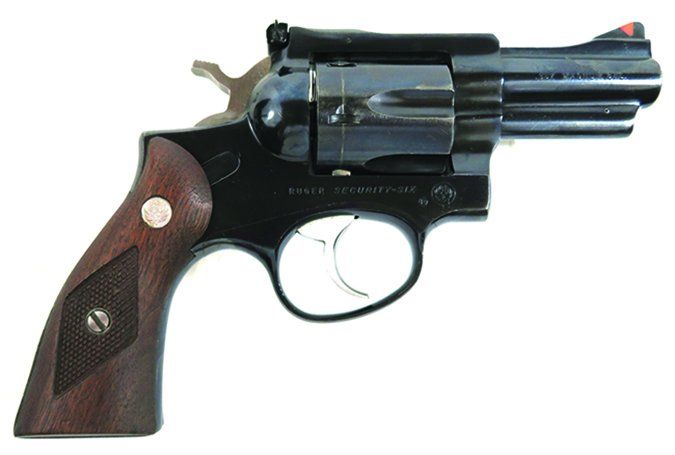
| ACTION TYPE | DA/SA |
| OVERALL LENGTH | 7.8 in. |
| BARREL LENGTH | 2.7 in. |
| SIGHT RADIUS | 4.7 in. |
| OVERALL HEIGHT | 4.8 in. |
| MAX WIDTH | 1.5 in. |
| WEIGHT UNLOADED | 32.2 oz. |
| WEIGHT LOADED | 27.12 oz. |
| CYLINDER GAP | .003 |
| CAPACITY | 6 |
| FRAME FINISH | Blue |
| BARREL/CYLINDER FINISH | Blue |
| FRAME FRONT STRAP HEIGHT | 2.2 in. |
| FRAME BACK STRAP HEIGHT | 3.7 in. |
| GRIP | Checkered wood |
| GRIP THICKNESS (max) | 1.4 in. |
| GRIP CIRCUMFERENCE (max) | 4.6 in. |
| FRONT SIGHT | Ramped pinned, red insert blade |
| REAR SIGHT | Adjustable |
| TRIGGER PULL WEIGHT (DA) | 12 lbs. |
| TRIGGER PULL WEIGHT (SA) | 4.4 lbs. |
| SAFETY | Internal transfer bar |
| WARRANTY | None |
| TELEPHONE | (928) 541-8892 |
| WEBSITE | Ruger.com |
| MADE IN | USA |
The Security Six model was produced by Ruger from 1970 to 1985 and was known as a ruggedly built revolver. Ruger revolvers are designed to be field stripped into a few components, unlike the S&W and Colt. To access the action mechanism with the S&W and Colt, tools and patience are needed. The ability to be field-stripped was what helped separate Ruger revolvers from the others. In our opinion, the ability to field strip the Ruger is a positive trait, though most S&W and Colt revolvers do not need to be disassembled for a normal cleaning.
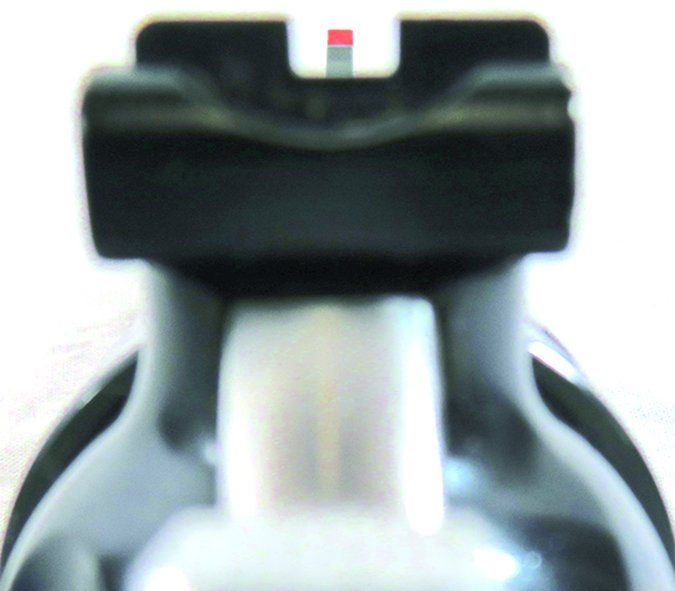
There is nothing slim or trim about the Ruger, and that heft did translate into less felt recoil. The grip size was between the larger Colt and smaller S&W. The area behind the trigger guard looked like it would jam up our fingers in recoil, but we found the revolver pleasant to shoot. It had a blued finish and mostly smooth wood grips. The grip had a palm swell and felt very comfortable in the hand.
The Security Six was equipped with large sights. Sight acquisition was simple, and it showed in our accuracy testing, with 5-shot groups averaging about 1.6 inches. The front sight is pinned so the blade could be replaced, depending on the load you choose. The blade also had a red insert—the predecessor to fiber optics—which made the front blade easier to pick up on a dark target. Not as helpful as a fiber optic, but better than plain black. The rear sight is adjustable, but we found no need to adjust it. It shot dead on out to 25 yards.
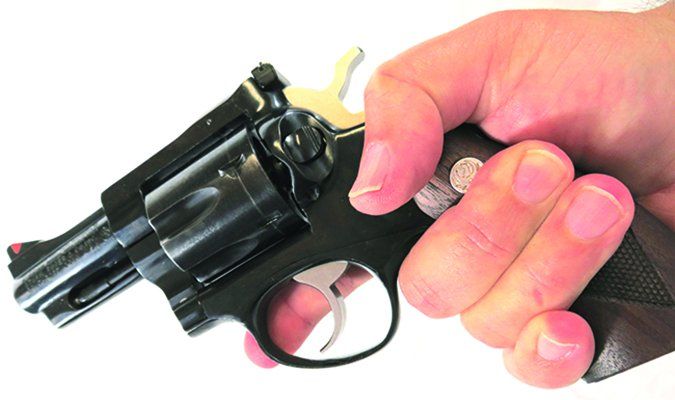
All three revolvers use a different method to open the cylinder. The Ruger uses a latch that is squeezed; the S&W latch is pushed, and the Colt’s is pulled. We could work all latch systems with confidence and speed, though most liked the S&W latch the best. The ejector rod of the Security Six is enclosed in a shroud under the barrel, which can make re-holstering the revolver easier. A pin in the ejector shroud snaps into the front of the ejector rod. We liked the six-round capacity.
The DA trigger was smooth and felt lighter than the 12 pounds it measured. We liked this trigger almost as much as the S&W’s.
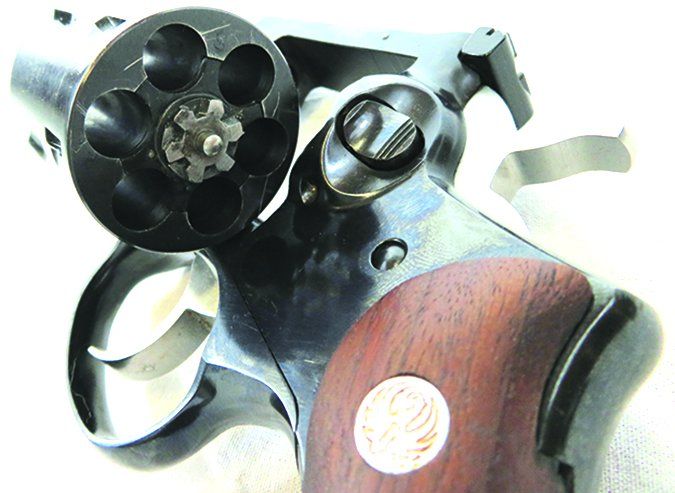
At 25 yards on top of a rest, the Security Six produced 5-shot groups that averaged 1.6 inches. It liked the Aguila with the 158-grain bullet the best. Our best group averaged 0.8 inches—not bad for a snubnose revolver. On the downside was its bulk. It was taller and heavier than the S&W, but smaller than the Colt. Wearing the Security Six in an IWB holster means buying pants a size larger to accommodate it.
Our Team Said: Several traits made the Security Six worth a look: Six shots, the heft to handle the recoil of 357 Magnum loads, and large sights, which offered a good sight picture. But the Ruger was not concealed-carry friendly—there were lots of sharp edges to snag on clothing. Even so, we would not hesitate to keep the Security Six in the nightstand drawer or carry it where open-carry is legal.
Colt Lawman Mk III 357 Magnum, $470-$525
GUN TESTS GRADE: B
The Lawman is a full-size revolver, so it was less concealable. It offered pleasant recoil as a result, However, the double-action trigger pull was too heavy, and the sights were too small.
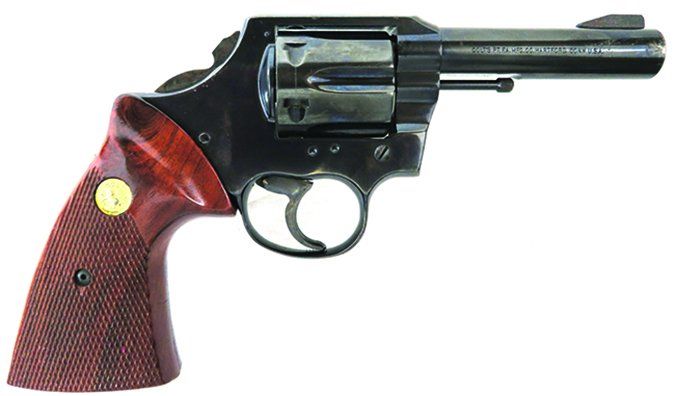
| ACTION TYPE | DA/SA |
| OVERALL LENGTH | 9.3 in. |
| BARREL LENGTH | 4 in. |
| SIGHT RADIUS | 5.2 in. |
| OVERALL HEIGHT | 5.3 in. |
| MAX WIDTH | 1.5 in. |
| WEIGHT UNLOADED | 32.4 oz. |
| WEIGHT LOADED | 32.8 oz. |
| CYLINDER GAP | .003 |
| CAPACITY | 6 |
| FRAME FINISH | Blue |
| BARREL/CYLINDER FINISH | Blue |
| FRAME FRONT STRAP HEIGHT | 2.2 in. |
| FRAME BACK STRAP HEIGHT | 4 in. |
| GRIP | Checkered wood |
| GRIP THICKNESS (max) | 1.5 in. |
| GRIP CIRCUMFERENCE (max) | 6.5 in. |
| FRONT SIGHT | Ramped blade |
| REAR SIGHT | Fixed groove |
| TRIGGER PULL WEIGHT (DA) | 15 lbs. |
| TRIGGER PULL WEIGHT (SA) | 5.3 lbs. |
| SAFETY | Internal transfer bar |
| WARRANTY | N/A |
| TELEPHONE | (800) 962-2658 |
| WEBSITE | Colt.com |
| MADE IN | USA |
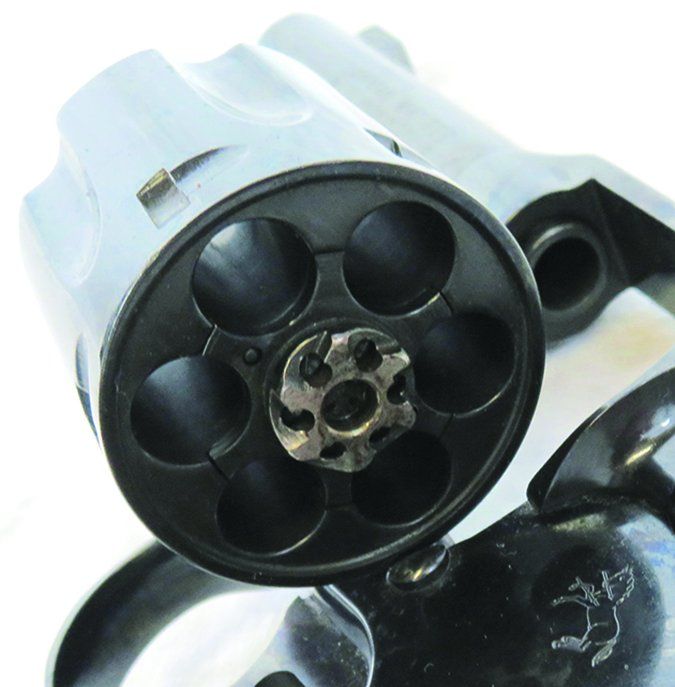
The Lawman Mk III was produced from 1969 and 1983 and evolved from Colt’s Trooper model. The Colt, like the Ruger and S&W, used a coiled main spring. We noticed stacking on the Colt. On the Smith & Wesson 649, we noticed none of that, and on the Ruger, only a very slight amount.
In fact, the trigger was the downfall of the Lawman. It was too heavy, near 15 pounds in double action, and the single-action trigger movement required more than 5 pounds of pull. Not a good trait for accurate shooting.
This example was modified by a previous owner, who bobbed the hammer. We would have a new hammer with a spur installed so we could easily fire the revolver in SA. We still tested for accuracy in SA mode, though the hammer needed to be pulled rearward by our support-hand thumb. The revolver had a nice blue job, though it was worn from use at the sharp edges and muzzle. The large wood grips were checkered and filled a user’s hand to comfortably distribute the felt recoil.
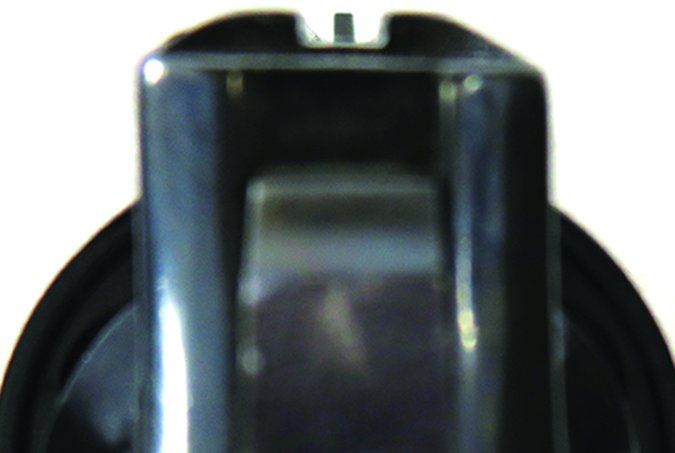
The Colt was much larger than the Ruger and S&W and heavier as well, but the Lawman had fewer sharp edges than the Ruger. Part of that was due to the smaller sights on the Lawman. The front sight was fixed to the barrel, and rear sight consisted of a groove in the top strap. The ejector rod was also not fitted into a barrel shroud, but in fact was milled under the barrel to reduce the space between the top of the ejector rod and the bottom of the barrel. The Colt looked old school for sure. Like the Ruger, the Colt has a six-round capacity.
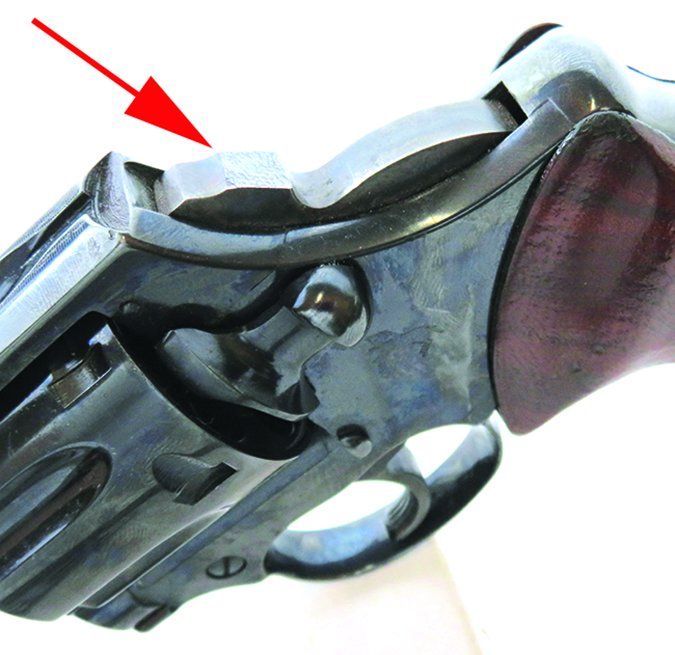
At 25 yards on top of a rest, the Lawman Mk III produced 5-shot groups that averaged 2.4 inches. It was pretty consistent with all ammo tested. Since the sights were smaller, they were less effective. The sights were also black on black, and on a dark background, the sights were lost to some users. Ejecting empties was effortless. Cartridges dropped easily into the chambers. The serrated trigger had a very heavy DA pull of about 15 pounds with stacking. We did not like it. In SA mode, the pull was over 5 pounds. Clearly, the Lawman needed a better trigger. If we owned this revolver, we’d send it back to Colt to install a new hammer with a spur and lighten the trigger pull.
Most found the Lawman revolver was easier to conceal carry in an IWB holster, though the large grip printed pretty obviously, depending on the concealing garment.
Our Team Said: There was less to like about the Lawman Mk III. The fuller grip made shooting pleasant, but it was a liability in concealed carry. The Colt performed, but it was harder to shoot it well due to the small sights and heavy trigger pull.
Special thanks to Eastern Outfitters of Hampstead, North Carolina, for their assistance. Written and photographed by Robert Sadowski, using evaluations from Gun Tests team testers.





























